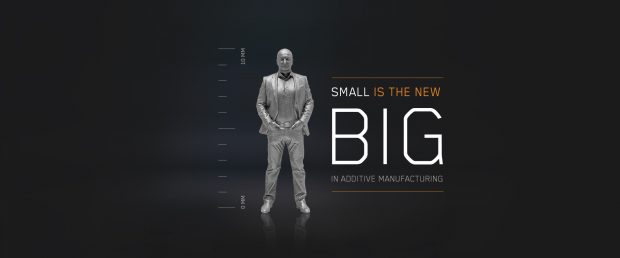Editor’s Pick: Binder Jetting 3D Printer Produces Metal Objects

The DM P2500 uses Digital Metal’s proprietary binder jetting technology to 3D print high-accuracy metal parts. The system can 3D print small parts with fine details that cannot be seen with normal vision, as shown here with this 10 mm Iron Man. Image courtesy of Digital Metal.
Latest News
October 25, 2017
 Here's an interesting item about a proven industrial 3D metal printing technology that's new to the commercial market. It's called the DM P2500, and it’s a 3D printer from an outfit known as Digital Metal.
Here's an interesting item about a proven industrial 3D metal printing technology that's new to the commercial market. It's called the DM P2500, and it’s a 3D printer from an outfit known as Digital Metal.
Digital Metal provides 3D printing services to a diverse set of clients in industries like automotive, aerospace, luxury goods, medical devices and industrial equipment. At the core of its 3D print services is a proprietary binder jetting technology. Using this technology, Digital Metal has made about 200,000 pieces for clients over the last four years. The DM P2500 is the commercial realization of this technology.
 The DM P2500 3D printer uses Digital Metal's proprietary binder jetting technology to 3D print high-accuracy metal parts. The system can 3D print small parts with fine details that cannot be seen with normal vision, as shown here with this 10 mm Iron Man. Image courtesy of Digital Metal.
The DM P2500 3D printer uses Digital Metal's proprietary binder jetting technology to 3D print high-accuracy metal parts. The system can 3D print small parts with fine details that cannot be seen with normal vision, as shown here with this 10 mm Iron Man. Image courtesy of Digital Metal.As you surmise, the DM P2500 builds objects layer by layer using metal powder and high-precision binder jetting. The process is said to be fast, highly accurate as well as repeatable. Layer thickness is 42 µm. Resolution is 35 µm. Available materials options currently include stainless steel and titanium.
Digital Metal
Digital Metal's binder jetting technology has a number of notable attributes. Perhaps foremost, you sinter the part for strength and correct material properties after the build. So 3D printing happens at room temperature and without some chamber of protective gas. Printing and heat treatment are separate processes, which should minimize downtime between 3D print runs.
But it also means that parts do not need hardened supports because, without melting during the print, the material supports itself. And because there is no heat during the print process, warping and shrinkage are less likely to occur. That should reduce scrap and rework. It surely means a lot less post-processing.
Now, put all that accuracy, resolution and repeatability together and what you have here is the ability make tiny and intricate parts in volume. Digital Metal says that you can stack parts and build up to 50,000 small objects in a single print run. That little dude up there? He's 10 mm tall yet you can clearly see creases in his pants and shirt buttons. In the first video linked off today's Editor's Pick of the Week write-up, there's a way cool close-up of the little fella, held between a pair of fingers.
As small as the dude is, he shows that the potential here to do things with the DM P2500 you could never do before seems enormous. Hit the link to today's main write-up to learn more about the DM P2500. As always, a bunch of links lead to deeper details.
Thanks, Pal. – Lockwood
Anthony J. Lockwood
Editor at Large, DE
Subscribe to our FREE magazine, FREE email newsletters or both!
Latest News
About the Author
Anthony J. Lockwood is Digital Engineering’s founding editor. He is now retired. Contact him via [email protected].
Follow DE





